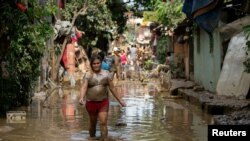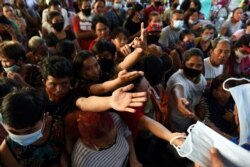Disaster response teams, police and soldiers joined forces Friday in a search for 20 people who have been missing in the Philippines since a typhoon made landfall in the capital city, Manila, earlier this week.
Residents of the island of Luzon withstood winds of 150 kph (93 mph) as Typhoon Vamco passed through Wednesday, forcing more than 400,000 people to evacuate or seek higher ground. According to the Associated Press, more than 3.8 million households lost power in the capital, with tens of thousands of homes destroyed by flash flooding and floating debris.
Of the 1.6 million Philippines residents affected, early reports indicate that Typhoon Vamco killed at least 42 people. National police report that among the dead were at least 12 villagers who were trapped underneath mud and rockslides in the northern regions of Cagayan and Nueva Vizcaya.
As floodwater began to recede, the military said it was still attempting to rescue those trapped in their communities. In some areas, stagnant water reached up to the second and third stories of homes.
President Rodrigo Duterte pledged Thursday to provide shelter, relief goods, financial assistance and counseling for affected residents.
Typhoon Vamco struck the island of Luzon just a week and a half after the Philippines endured Super Typhoon Goni, the world's strongest typhoon of 2020. More than 30 people have been reported dead or missing as a result of Goni.
Vamco is the fifth storm to impact the Philippines in three weeks. The region is hit by roughly 20 tropical storms each year. Experts estimate that typhoons are becoming stronger, according to a May study by the U.S. National Oceanic and Atmospheric Administration, with climate change blamed for the more powerful tropical cyclones.
Reuters news agency reported that after Vamco, the state weather forecaster warned that three more typhoons could hit the islands before the end of the year.









